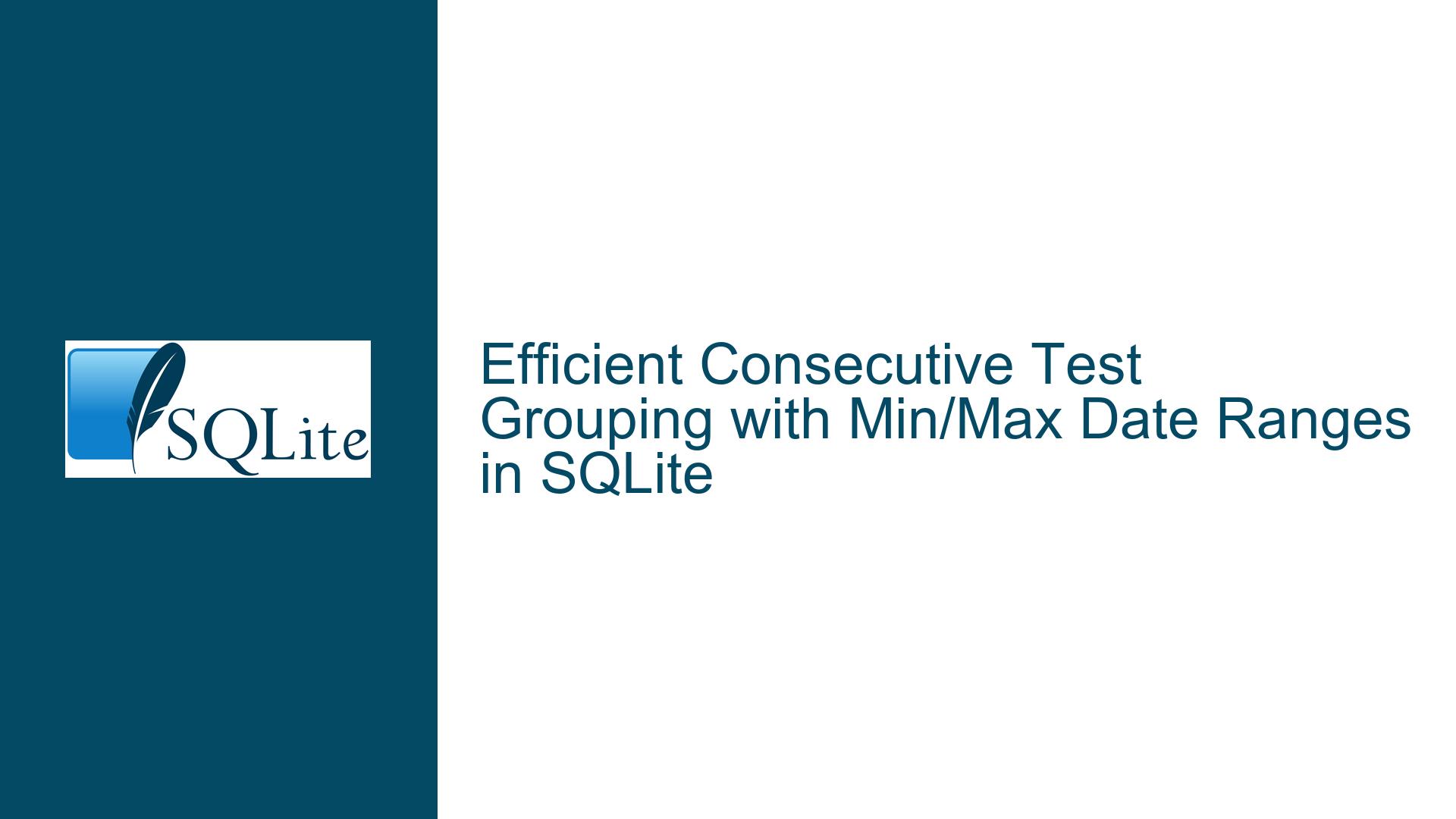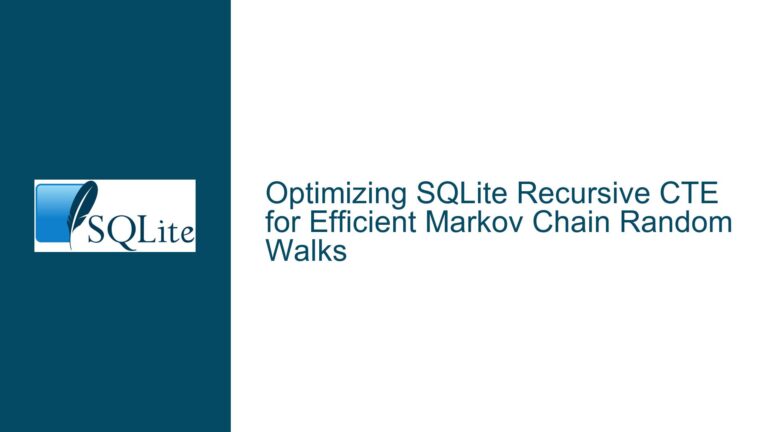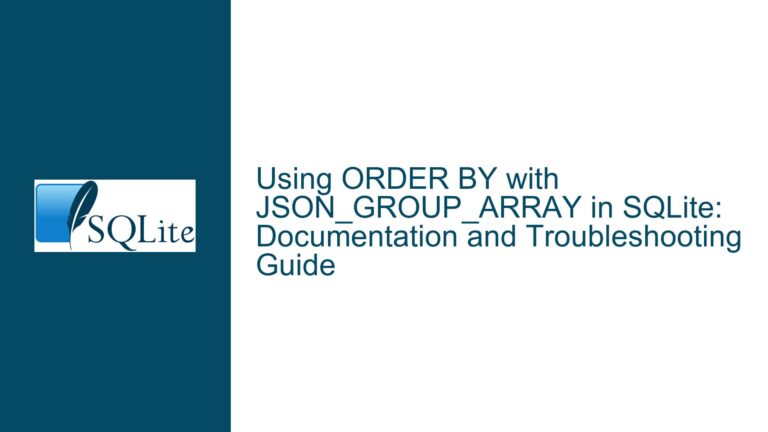Efficient Consecutive Test Grouping with Min/Max Date Ranges in SQLite
Identifying Consecutive Test Groups and Date Range Aggregation Requirements
The core challenge involves transforming a sequence of dated test records into contiguous groups where the test type remains consistent. Each group must be represented by its minimum (fromdate) and maximum (enddate) dates, with non-overlapping ranges. Consider the following input data:
CREATE TABLE T(
date INTEGER PRIMARY KEY,
test CHAR (12)
);
INSERT INTO T VALUES
(1, 'clim'), (3, 'clim'), (7, 'amb'), (10, 'amb'),
(12, 'xxx'), (13, 'clim'), (15, 'clim'), (20, 'clim'),
(22, 'amb'), (25, 'amb');
The desired output identifies five distinct groups:
fromdate | enddate | test
----------------------------
1 | 3 | clim
7 | 10 | amb
12 | 12 | xxx
13 | 20 | clim
22 | 25 | amb
Key Technical Constraints:
- Groups are defined by consecutive dates sharing the same test value.
- Date gaps between entries with the same test do not create new groups (e.g., clim from 13-20 includes dates 13,15,20).
- The solution must avoid O(n²) computational complexity for large datasets.
The initial approach uses a self-join to identify group boundaries by comparing each row to all prior rows with different test values. A window function alternative attempts to reduce computational overhead by tracking test changes through ordered comparisons. A third approach leverages procedural iteration for O(n) linear processing.
Performance Implications of Self-Joins, Window Functions, and Procedural Iteration
1. Self-Join with CTE: Indexed but Quadratic Complexity
CREATE INDEX t_date_test ON T(date, test);
WITH x AS (
SELECT
t.date,
t.test,
MAX(t_prev.date) AS group_key
FROM T
LEFT JOIN T t_prev
ON t_prev.date < t.date
AND t_prev.test != t.test
GROUP BY t.date, t.test
)
SELECT
MIN(date) AS fromdate,
MAX(date) AS enddate,
test
FROM x
GROUP BY group_key, test
ORDER BY fromdate;
Strengths:
- Leverages indexed columns for efficient range scans.
- Clear logical separation between group identification and aggregation.
Weaknesses:
- The LEFT JOIN condition
t_prev.date < t.date AND t_prev.test != t.testforces a full scan of prior rows for each date. - GROUP BY on computed
group_keyintroduces temporary sorting. - Query plan reveals nested loops with O(n²) growth in operations.
2. Window Functions: Linear Scans with Hidden Sorting Costs
WITH
change_detection AS (
SELECT
date,
test,
LAG(test) OVER (ORDER BY date) != test AS is_new_group
FROM T
),
group_assignment AS (
SELECT
date,
test,
SUM(is_new_group) OVER (ORDER BY date) AS group_id
FROM change_detection
)
SELECT
MIN(date) AS fromdate,
MAX(date) AS enddate,
test
FROM group_assignment
GROUP BY group_id
ORDER BY fromdate;
Strengths:
- Single table scan using index for window ordering.
- SUM() over window creates unique group identifiers without joins.
Weaknesses:
- LAG() comparison requires materializing the entire window frame.
- SUM() window aggregation forces intermediate storage of all rows.
- Hidden sorting operations for window partitioning consume memory.
3. Procedural Iteration: Optimal Complexity with Language Overhead
The procedural approach uses cursor-based iteration to track group boundaries:
- Order rows by date.
- Compare current test to previous test.
- Reset group boundaries on test change.
Strengths:
- Single pass over data with O(n) time complexity.
- Minimal memory overhead (stores only active group boundaries).
Weaknesses:
- Requires external language integration (C, Python, etc.).
- Loses declarative SQL advantages for query optimization.
- Increased code complexity for edge case handling.
Optimizing Grouping Performance Through Index Design, Query Tuning, and Hybrid Approaches
Step 1: Validate Index Utilization
Clustered Index Optimization:
CREATE TABLE T(
date INTEGER PRIMARY KEY, -- Implicit clustered index
test CHAR (12)
);
-- Covering index for window function approach
CREATE INDEX t_covering ON T(date, test);
- Clustered index organizes data physically by date, accelerating range scans.
- Covering index eliminates table heap accesses in window function queries.
Query Plan Analysis:
EXPLAIN QUERY PLAN
WITH ... [window function query] ...;
Verify output for:
SCAN TABLE T USING INDEX t_covering(desired)- Absence of
TEMPORARY TABLEorFILESORToperations
Step 2: Tune Window Function Queries
Reduce Window Frame Overhead:
-- Explicitly define window frame for SUM()
SUM(is_new_group) OVER (
ORDER BY date
ROWS BETWEEN UNBOUNDED PRECEDING AND CURRENT ROW
) AS group_id
- Restricts window frame to necessary rows only.
- Prevents default
RANGEmode, which may trigger sorting.
Materialize Intermediate Results:
CREATE TEMP TABLE change_detection AS
SELECT
date,
test,
LAG(test) OVER (ORDER BY date) != test AS is_new_group
FROM T;
ANALYZE change_detection;
- Materializing intermediate results allows SQLite to optimize subsequent stages.
- ANALYZE updates statistics for better query planning.
Step 3: Benchmark Self-Join vs. Window Function Approaches
Test Data Generation:
-- Generate 100,000 test records with varying group sizes
WITH RECURSIVE generate_dates(date) AS (
SELECT 1
UNION ALL
SELECT date + 1 FROM generate_dates WHERE date < 100000
)
INSERT INTO T(date, test)
SELECT
date,
CASE WHEN date % 1000 = 0 THEN 'amb'
WHEN date % 300 = 0 THEN 'clim'
ELSE 'xxx' END
FROM generate_dates;
Execution Time Measurement:
# Self-join approach
time sqlite3 test.db <<EOF
.headers off
[Self-join query here]
EOF
# Window function approach
time sqlite3 test.db <<EOF
.headers off
[Window function query here]
EOF
Expected Results:
- Self-join: Execution time grows quadratically (e.g., 10s for 10k rows → 100s for 100k).
- Window functions: Linear growth with higher constant factors (e.g., 2s → 20s).
Step 4: Implement Hybrid SQL/Procedural Solution
SQLite C Extension for Group Aggregation:
#include <sqlite3ext.h>
SQLITE_EXTENSION_INIT1
typedef struct {
int min_date;
int max_date;
const char *test;
} GroupState;
static void group_step(
sqlite3_context *ctx,
int argc,
sqlite3_value **argv
) {
GroupState *state = sqlite3_aggregate_context(ctx, sizeof(GroupState));
int current_date = sqlite3_value_int(argv[0]);
const char *current_test = (const char *)sqlite3_value_text(argv[1]);
if (!state->test) { // First row
state->min_date = current_date;
state->max_date = current_date;
state->test = current_test;
} else if (strcmp(state->test, current_test) == 0) {
state->max_date = current_date;
} else { // Test changed; emit group
sqlite3_result_int(ctx, state->min_date);
sqlite3_result_int(ctx, state->max_date);
sqlite3_result_text(ctx, state->test, -1, SQLITE_STATIC);
// Reset for next group
state->min_date = current_date;
state->max_date = current_date;
state->test = current_test;
}
}
static void group_final(sqlite3_context *ctx) {
GroupState *state = sqlite3_aggregate_context(ctx, 0);
if (state) {
sqlite3_result_int(ctx, state->min_date);
sqlite3_result_int(ctx, state->max_date);
sqlite3_result_text(ctx, state->test, -1, SQLITE_STATIC);
}
}
int sqlite3_group_init(
sqlite3 *db,
char **pzErrMsg,
const sqlite3_api_routines *pApi
) {
SQLITE_EXTENSION_INIT2(pApi);
sqlite3_create_function_v2(
db, "test_group", 2,
SQLITE_UTF8 | SQLITE_DETERMINISTIC,
0, 0, group_step, group_final
);
return SQLITE_OK;
}
Usage:
SELECT test_group(date, test) FROM T ORDER BY date;
-- Returns: min_date|max_date|test for each group
Performance Characteristics:
- Single table scan with O(n) time.
- Minimal memory overhead (stores only active group state).
- Requires C compiler and SQLite extension loading.
Step 5: Choose the Optimal Approach Based on Data Scale
Decision Matrix:
| Dataset Size | Recommended Approach | Rationale |
|---|---|---|
| < 10k rows | Window Function Query | Declarative, no external dependencies |
| 10k – 1M | Self-Join with Covering Index | Balance between SQL simplicity and speed |
| > 1M rows | Procedural Extension or Application | Avoid O(n²) and window sorting overhead |
Application-Level Implementation (Python Example):
import sqlite3
def generate_groups(db_path):
conn = sqlite3.connect(db_path)
conn.row_factory = sqlite3.Row
cursor = conn.cursor()
cursor.execute("SELECT date, test FROM T ORDER BY date")
current_group = None
for row in cursor:
if not current_group:
current_group = {
'fromdate': row['date'],
'enddate': row['date'],
'test': row['test']
}
elif row['test'] == current_group['test']:
current_group['enddate'] = row['date']
else:
yield current_group
current_group = {
'fromdate': row['date'],
'enddate': row['date'],
'test': row['test']
}
if current_group:
yield current_group
# Usage:
for group in generate_groups('test.db'):
print(group['fromdate'], group['enddate'], group['test'])
Advantages:
- Stream processing with O(1) memory for active group.
- No SQL query optimization uncertainty.
- Easily handles datasets exceeding available RAM.
Final Recommendations
- For Embedded Systems: Use window function queries with a covering index
(date, test). Monitor query plans for temporary table usage. - ETL Pipelines: Implement procedural aggregation in the extraction layer (Python, Java, etc.) to minimize database load.
- High-Volume Applications: Develop a custom SQLite extension for grouping logic, combining O(n) speed with in-process execution.
Critical Trade-off Consideration: SQL-based approaches maintain declarative clarity but sacrifice performance at scale. Procedural methods invert this trade-off, prioritizing efficiency over portability. The optimal solution depends on operational constraints around code maintainability, data volume, and system architecture.






